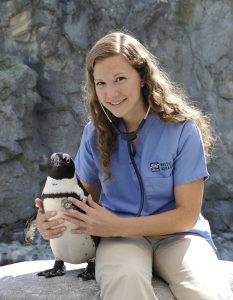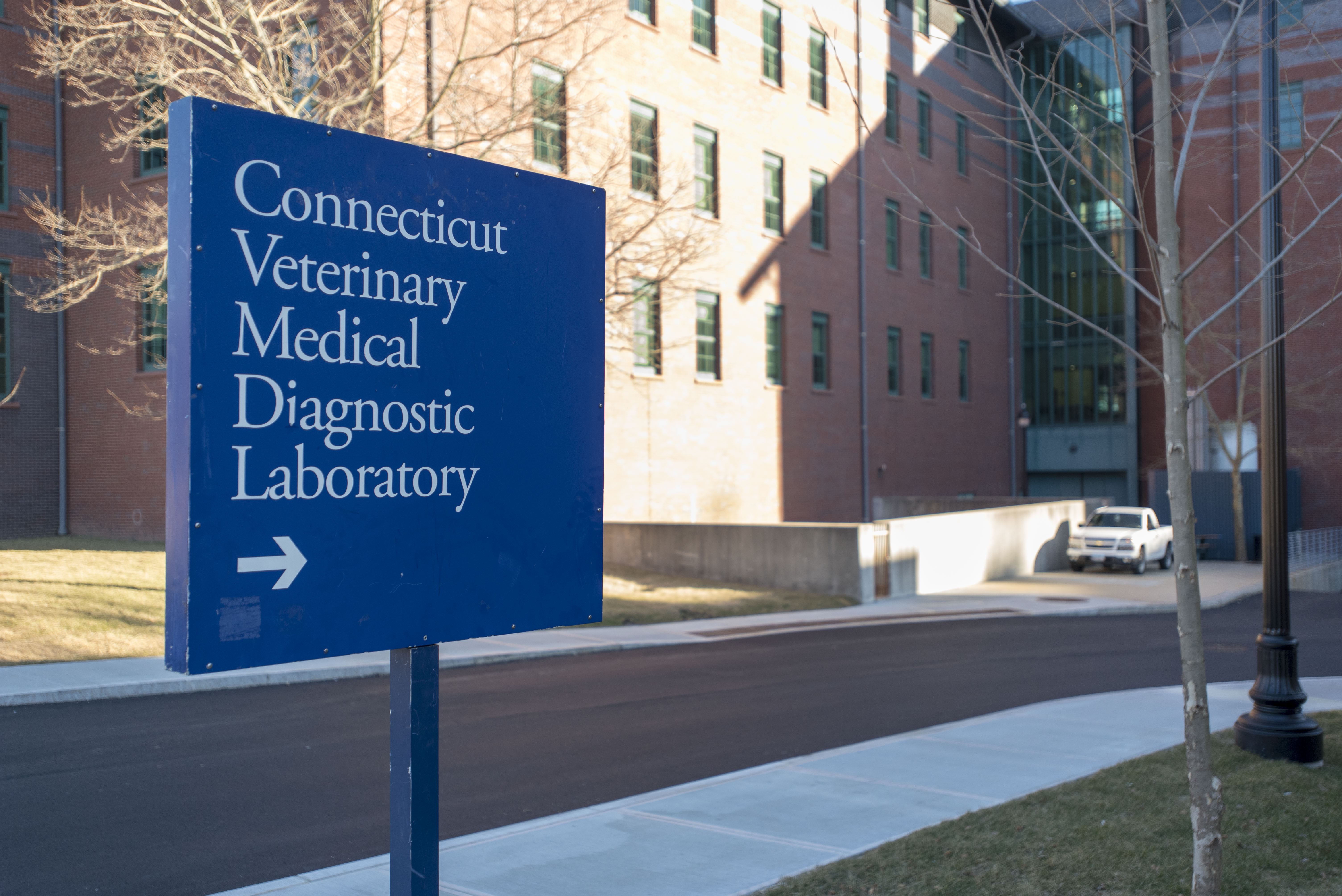Visiting an aquarium transports people to another world: an underwater world filled with many different plants and animals. Connecticut’s famous Mystic Aquarium cares for 5,000 animals from over 355 species, from octopuses to beluga whales to sea lions. Studying these animals offers a unique opportunity to learn about conserving these species in the wild, in support of the aquarium’s mission to care for and protect our ocean planet through conservation, education, and research.
Behind habitats that feature brightly-colored fish and a diversity of other animals, like beluga whales that appear to engage with visitors, are the professionals – veterinarians, aquarists, trainers, divers, and environmental quality staff – that protect the health, safety, and wellbeing of the animals. The Connecticut Veterinary Medical Diagnostic Laboratory (CVMDL) in the Department of Pathobiology and Veterinary Science at UConn’s College of Agriculture, Health and Natural Resources is a partner in protecting and enhancing the health of the aquatic animals at Mystic Aquarium, and has collaborated with its veterinarians for almost 30 years.
CVMDL partners with Mystic Aquarium on diagnostics and research to advance aquatic animal care and health, and shares these initiatives with the larger scientific and educational communities.
The partnership between CVMDL and Mystic Aquarium started with Dr. Salvatore Frasca Jr., the director of CVMDL. Frasca’s research focus is on pathology and diagnostics of aquatic animals. Service, through his appointment with UConn Extension and work with CVMDL, has always been a key component of his work.
“I chose UConn because it was close to Mystic Aquarium,” Frasca says. “I’m proud and pleased that CVMDL, through our service and educational activities, has been supporting Mystic Aquarium for over 30 years. We have a legacy of Extension activities at Mystic Aquarium that many people from both organizations have been part of.”
Frasca was enrolled in the Residency/Ph.D. program in veterinary anatomic pathology at UConn in the 1990s after earning his veterinary degree from the University of Pennsylvania. Prior to that, he had worked closely with Dr. J. Lawrence Dunn, the veterinarian at Mystic Aquarium at the time. The two realized there was a nationwide shortage of educational opportunities for veterinarians to learn aquatic animal medicine. Together, they wrote a grant to create an internship program at Mystic Aquarium.
Mystic Aquarium’s Internship in Aquatic Animal Medicine and Research teaches veterinarians how to apply and develop their skills for the benefit of aquatic animals and helps veterinarians further develop their expertise with research. It was the first aquatic marine animal veterinary internship ever offered, and Mystic Aquarium’s internship program has since trained nearly 30 veterinarians, many of whom are now leaders in the field of aquatic animal medicine, including two of the veterinarians currently employed at Mystic Aquarium itself. After receiving the grant, Frasca was encouraged to apply, and served as the first veterinary intern in the program in 1992. For nearly thirty years the program has continued to train veterinarians in aquatic animal health and has prompted similar opportunities in other locations.
The idea of developing educational experiences in clinical medicine and pathology was the foundation of the original partnership. CVMDL provides the pathology component, and Mystic Aquarium has the clinical component. They are parallel tracks that weave back and forth because of the nature of the programs. Veterinarians come to UConn’s residency program in veterinary anatomic pathology, in part, because they want to gain experience with aquatic animals. CVMDL integrates aquatic animals into the fabric of the training material and provides transformational learning experiences.
Enhancing Animal Health and Conservation
Dr. Allison Tuttle is the Senior Vice President of Zoologic Operations at Mystic Aquarium. She was introduced to Mystic Aquarium on a tour with the AQUAVET program, and then served as the Veterinary Intern in Aquatic Animal Medicine and Research from 2002 to 2004. Tuttle re-joined the aquarium as Director of Animal Care in 2007, when Dunn retired. In her current role, Tuttle oversees animal husbandry, animal rescue, veterinary services, environmental quality, the dive program, and exhibit interpretation.

“I fell in love with Mystic Aquarium on that initial tour,” Tuttle says. “There is a nice balance of opportunities among the programs we have, and we play a key role in wild marine animal rescue for our region.”
Mystic Aquarium’s Animal Rescue Program manages 1,000 miles of coastline and monitors deceased wild marine mammals and sea turtles to determine their cause of death. The aquarium sends samples to CVMDL for histopathologic analysis, which provides critically important information on what is happening in our oceans. The aquarium submits reports containing this data to federal agencies, and these reports are utilized to shape regulations and policies preventing fisheries and human interaction, which is important for marine mammal and sea turtle conservation.
“Our oceans are changing, and there are a lot of unusual mortality events, in particular with large whale species in the greater Atlantic region,” Tuttle says. “As new issues emerge with the ocean it becomes increasingly important to monitor what is occurring. It’s tremendously difficult to study these whales; the data we collect is sometimes the only information we have on these animals.”
CVMDL’s pathology and diagnostic services have been integral to the health of Mystic Aquarium’s animals as well. They partner on sample analysis for their animals as well as on scientific collaborations. The aquarium sends samples to CVMDL for histopathologic analysis and biopsies on active clinical cases. The results from CVMDL are important in the management of a healthy, robust population, by informing treatment and allowing for the best animal care possible.
Scientific research is another area where Mystic Aquarium and CVMDL collaborate. Aquatic clinical medicine and pathology go hand-in-hand. For example, Mystic Aquarium worked with CVMDL and the Connecticut Agricultural Experiment Station to report Eastern Equine Encephalitis (EEE) infection in a colony of penguins in 2003. Until that report, EEE infection in penguins had not been described. They published their findings in the Journal of the American Veterinary Medical Association.
“Mystic Aquarium has a great relationship with UConn and Dr. Frasca,” says Tuttle. “We have a strong connection with UConn, and our conservation and animal care are greatly enhanced through our partnership with CVMDL.”
CVMDL is on the front lines of research and testing to keep humans and animals safe. The aquatic animal pathology service is one part of their work. Clients include those within the state, such as Mystic Aquarium and The Maritime Aquarium at Norwalk, and clients and aquariums from across the country. The laboratory offers diagnostic testing in support of pathology, including bacterial and fungal culture and molecular testing. The long-standing service history in aquatic animal pathology started with the relationship with Mystic Aquarium, and now serves a number of other aquariums nationwide.
“CVMDL is committed to working with Mystic Aquarium, we’ve always known that Mystic Aquarium is a special asset for Connecticut,” Frasca concludes. “Extension activity is born of confluence and synergy of educational activities. That is exactly what happened with Mystic Aquarium.”



